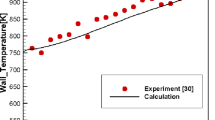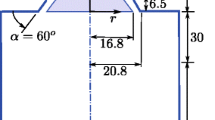Abstract
An accurate knowledge of heat transfer and temperature distribution in vehicle engines is essential to have a good management of heat transfer performance in combustion engines. This may be achieved by numerical simulation of flow through the engine cooling passages; but the task becomes particularly challenging when boiling occurs. Neglecting two phase flow processes in the simulation would however result in significant inaccuracy in the predictions. In this study a three dimensional numerical model is proposed using Fluent 6.3 to simulate heat transfer of fluid flowing through channels of conventional size. Results of the present theoretical and numerical model are then compared with some empirical results. For high fluid flow velocities, departure between experimental and numerical results is about 9 %, while for lower velocity conditions, the model inaccuracy increases to 18 %. One of the outstanding capabilities of the present model, beside its ability to simulate two phase fluid flow and heat transfer in three dimensions, is the prediction of the location of bubble formation and condensation which can be a key issue in the evaluation of the engine performance and thermal stresses.


















Similar content being viewed by others
Abbreviations
- A:
-
Bubble influence factor
- CpL :
-
Specific heat capacity of liquid (J/kg K)
- CpG :
-
Specific heat capacity of vapour (J/kg K)
- dW :
-
Bubble departure diameter on the wall (m)
- dB :
-
Mean bubble diameter in the bulk flow (m)
- E :
-
Empirical constant (=9.793)
- F:
-
Bubble departure frequency
- G:
-
Gravitational acceleration (m/s2)
- H:
-
Coefficient for convection heat transfer (W/m2 K)
- hQ :
-
Coefficient for heat transfer by quenching (W/m2 K)
- K:
-
Heat conductivity (W/m K)
- k eff :
-
Effective conductivity (W/m K)
- K p :
-
Turbulence kinetic energy at point P (J)
- \( \dot{m}_{qp} \) :
-
Mass transfer from phase q to phase p (kg/s)
- \( \dot{m}_{pq} \) :
-
Mass transfer from phase p to phase q (kg/s)
- \( \dot{m}_{w} \) :
-
Mass of evaporation (kg/s)
- Na :
-
Active nucleation site density
- Pr:
-
Prandtl number of liquid
- qF :
-
Heat flux by single-phase convection (W/m2)
- qQ :
-
Heat flux by quenching (W/m2)
- QE :
-
Heat by evaporation (W)
- QF :
-
Single-phase turbulent convection heat transfer (W)
- QQ :
-
Heat transfer due to the replacement of departed bubbles by colder fluid of upper layers (W)
- Qtot :
-
Total heat (W)
- Tb :
-
Bulk temperature (average temperature at each section) (°C)
- TL :
-
Near-wall liquid temperature (°C)
- Tsat :
-
Saturation temperature (°C)
- ΔT sub,LW :
-
Liquid sub-cooling (°C)
- ΔT sup :
-
Superheating (°C)
- TW :
-
Wall temperature (°C)
- TLW :
-
Liquid characteristic near-wall temperature (°C)
- tW :
-
Waiting time (s)
- U:
-
Velocity (m/s)
- U c :
-
Mean velocity magnitude at \( {\text{y}}^{*} = {\text{y}}_{\text{T}}^{*} \) (m/s)
- y p :
-
Distance from point P to the wall (m)
- y+ :
-
Non-dimensional distance to the wall
- α:
-
Volume fraction of bubbles
- ρG :
-
Vapour density (kg/m3)
- ρL :
-
Liquid density (kg/m3)
- ρm :
-
Mixture density (kg/m3)
- Ω:
-
Area fraction occupied by bubbles (m2)
- v m :
-
Averaged velocity (m/s)
- μ m :
-
Viscosity of the mixture (Pa s)
- \( \overset{\lower0.5em\hbox{$\smash{\scriptscriptstyle\rightharpoonup}$}} {v}_{dr,k} \) :
-
Drift velocity for secondary phase k (m/s)
References
Marco PD (2003) Review of reduced gravity boiling heat transfer: European research. Therm Eng Microgravity (Part 1: Boil) 20(4):252–263
Dreitser GA (2005) Heat transfer enhancement in channels for film boiling of cryogenic liquids. Appl Therm Eng 25:2512–2521
Chen JC (1966) A correlation for boiling heat transfer to saturated fluids on convective flow. Ind Eng Chem Process Des Dev 5(3):322–329
Deev VI, Oo HL, Kharitonov VS, Kutsenko KV, Lavrukhin AA (2007) Critical heat flux modeling in water pool boiling during power transients. Int J Heat Mass Transf 50:3780–3787
Oh HK, Ku HG, Roh GS, Son CH, Park SJ (2008) Flow boiling heat transfer characteristics of carbon dioxide in a horizontal tube. Appl Therm Eng 28:1022–1030
Mosdorf R, Shoji M (2006) Temperature fluctuation at twin cavity in nucleate boiling—wavelet analysis and modelling. Int J Heat Mass Transf 49:3156–3166
Steiner H, Kobor A, Gebhard L (2005) A wall heat transfer model for subcooled boiling flow. Int J Heat Mass Transf 48:4161–4173
Yu W, France DM, Wambsganss MW, Hull JR (2002) Two-phase pressure drop, boiling heat transfer, and critical heat flux to water in a small-diameter horizontal tube. Int J Multiph Flow 28:927–941
Karamangil MI, Kaynakli O, Surmen A (2006) Parametric investigation of cylinder and jacket side convective heat transfer coefficients of gasoline engines. Energy Convers Manag 47:800–816
Lee HS, Cholewczynski LW (2003) A study on convection and boiling heat-transfer modes in a standard engine cooling system. In: Proceeding of SAE VTMS6, Brighton
Fluent software 6.3, Theory guide
Krepper E, Končar B, Egorov Y (2007) CFD modelling of subcooled boiling-concept, validation and application to fuel assembly design. Nucl Eng Des 237:716–731
Jayatilleke C (1969) The influence of Prandtl number and surface roughness on the resistance of the laminar sublayer to momentum and heat transfer. Prog Heat Mass Transf 321(1):193–202
Robinson K, Hawley JG, Campbell NA (2003) Experimental and modelling aspects of flow boiling heat transfer for application to internal combustion engines. Proc Instn Mech Eng Part D J Automob Eng 217(10):877–890
Hawley JG, Wilson M, Campbell NAF, Hammond GP, Leathard MJ (2004) Predicting boiling heat transfer using computational fluid dynamics. Inst Mech Eng (Part D) J Automob Eng 218(5):509–522
Hosny Z, Zayian A (2004) Forced convection and subcooled flow boiling heat transfer in asymmetrically heated ducts of T-section. Energy Convers Manag 4:1043–1065
Bartolomej GG, Chanturiya VM (1982) An experimental investigation of true volumetric vapour content with subcooled boiling in tubes. Therm Eng 29:132–135
Author information
Authors and Affiliations
Corresponding author
Rights and permissions
About this article
Cite this article
Mehdipour, R., Baniamerian, Z. & Delauré, Y. Three dimensional simulation of nucleate boiling heat and mass transfer in cooling passages of internal combustion engines. Heat Mass Transfer 52, 957–968 (2016). https://doi.org/10.1007/s00231-015-1611-6
Received:
Accepted:
Published:
Issue Date:
DOI: https://doi.org/10.1007/s00231-015-1611-6




